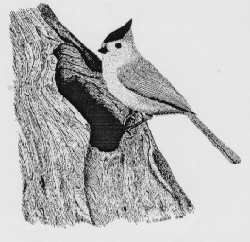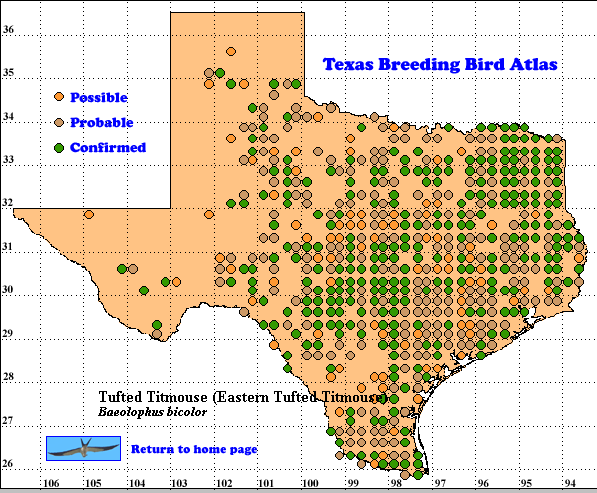Baeolophus bicolor
The Tufted Titmouse is a common resident of woodlands and residential areas in the eastern half of North America and in northeastern Mexico. Although very lively and inquisitive, it is often heard before seen, with its distinctive “peter-peter-peter” song. In Texas, it is represented by two forms: the Eastern Tufted Titmouse with a gray crest and black forehead, and the Black-crested Titmouse with a black crest and whitish forehead (Dixon 1955). The eastern form resides in the eastern third of the state and interbreeds with the Black-crested form where their ranges meet in central Texas, from Palo Pinto County south to eastern Travis County and on to Refugio County. The A.O.U. (1998) currently recognizes the two forms as conspecific and TBBAP records do not differentiate between the two forms.
DISTRIBUTION: In Texas, TBBAP data indicate that titmice breed mostly in the eastern woodlands, coastal prairies, south Texas brushlands, Edwards Plateau, and the north central plains. The gap in breeding records in the south Texas brushlands (latilongs 27099, 28098, and 28099) appears to be a result of incomplete coverage in TBBAP records for those areas and not as a gap in the range of the titmouse. In the region between the Edwards Plateau and the Trans-Pecos, titmice are sparsely distributed and some may have been missed due to incomplete TBBAP coverage in this area. The Trans-Pecos records are associated with woodlands at high elevations or along watercourses. Records along the Caprock Escarpment and in the Panhandle are associated with woodlands along the escarpment and in canyons.
SEASONAL OCCURRENCE: The Tufted Titmouse is an easy species to locate; however, breeding is somewhat more difficult to confirm. Only 31% of the 1233 TBBAP records represent confirmed records. Fledglings will beg noisily for three to five weeks after leaving the nest (Brackbill 1970) and this may explain why 77% of all confirmed sightings were of recently fledged young or adults feeding young.
This species has a long breeding season, lasting from mid-February to late June (Oberholser 1974). Oberholser reports egg dates from February 24 to June 11. TBBAP data document a later egg date of 20 June 1988 with eggs in a nest found in latilong 33098, quad H6.
BREEDING HABITAT: Tufted Titmice nest in natural cavities in both living and dead trees, in old woodpecker excavations, or less commonly in artificial nest boxes and even in tin cylinder newspaper boxes (Laskey 1957, Brackbill 1970). In the eastern part of their range, these cavities are generally located in a variety of woodland areas, oak groves, and forest margins. In more arid areas, titmice typically find cavities in streamside timber, live oak mottes of semiopen country, and in wooded ravines, gullies, and canyons.
Titmice line their nests with a variety of materials including bark fibers, grass, leaves, wool, fur, feathers, moss, and snake-skin. Double-brooding has not been documented for Texas, but has been reported elsewhere (Middleton 1949). Helping at the nest occurs with titmice, but is rare (Brackbill 1970).
STATUS: The status of the Tufted Titmouse in Texas is excellent and appears to be improving. Dixon (1955) and Oberholser (1974) describe the Panhandle population as restricted to Palo Duro Canyon, with few records between those and the Edwards Plateau populations. TBBAP data indicate that titmice are found all along the Caprock Escarpment connecting the western Edwards Plateau with the Panhandle. Breeding Bird Survey (Robbins et al. 1986) data show the titmouse range to be further north and west of the Edwards Plateau and closer to the escarpment than Oberholser indicates, but not as extensively along the escarpment as TBBAP data show. Although local checklists are not available for the entire Caprock area, several do include this species. The checklist for Crosby County (Llano Estacado Audubon Society 1976) regards this bird as a common resident. A checklist for Caprock Canyons State Park in Briscoe County (Seyffert 1989) lists this bird, but gives no indication of status. In addition, Arnold (1972) documented titmice on the east side of the Caprock in Foard and Cottle Counties. In Palo Duro Canyon, Dixon (1955) found the species to be rare, but recent checklists regard it as common (Seyffert & Acord 1987). Further evidence can be found in Midland County. The 1972 checklist (Williams 1972) shows only one record, but by 1992 the bird is regarded as irregular in winter and summer (Midland Naturalists 1992). Thus it would seem that the Tufted Titmouse has been expanding its range to the north and west from the Edwards Plateau.
In Culbertson County in the Trans-Pecos region, Tufted Titmouse sightings appear to be a recent occurrence. Dixon (1955) showed no records for the county and Oberholser (1974) included one questionable record. In Guadalupe Mountains National Park, older checklists do not list the bird (Newman 1974), but recent checklists regard it as occasional in spring and summer (Newman 1991). However, breeding has not been confirmed in the area. Cade L. Coldren
Text by Cade L. Coldren (ca. 1993)
Literature cited
American Ornithologists Union. 1983. Checklist of North American birds, 6th ed. Washington, D.C.
Arnold, K. A. 1972. Crested titmice from Cottle and Foard Counties, Texas. Bull. Texas Ornith. Soc. 5:23.
Brackbill, H. 1970. Tufted Titmouse breeding behavior. Auk 87: 522-536.
Dixon, K. L. 1955. An ecological analysis of the interbreeding of crested titmice in Texas. Univ. California Publ. Zool. 54: 125-205.
Laskey, A. R. 1957. Some Tufted Titmouse life history. Bird-Banding 28: 135-145.
Llano Estacado Audubon Society. 1976. A birder’s checklist of the Texas South Plains, 3rd ed. Lubbock, Texas.
Middleton, R. J. 1949. Tufted Titmouse nesting seven years. Bird-Banding 20: 151-152.
Midland Naturalists. 1992. Field check list of birds of Midland County, Texas, 10th ed. Midland, TX.
Newman, G. A. 1974. Check-list of birds: Guadalupe Mountains National Park, Culbertson County, Texas. Privately published.
Newman, G. A. 1991. Checklist of birds: Guadalupe Mountains National Park, Culbertson County, Texas. Carlsbad Caverns/Guadalupe Mountains Association. Carlsbad, NM.
Oberholser, H. C. 1974. The bird life of Texas. University of Texas Press, Austin.
Robbins, C. S., D. Bystrak, and P. H. Geissler. 1986. The breeding bird survey: Its first fifteen years, 1965-1979. U.S. Fish and Wildl. Serv., Resource Publ. No. 157.
Seyffert, K. D. 1989. Birds of Caprock Canyons State Park: A field checklist. Resource Management Section, Texas Parks and Wildlife Dept., Austin, Texas.
Seyffert, K. D., and P. Acord. 1987. Birds of Palo Duro Canyon State Park: A field checklist. Resource Management Section, Texas Parks and Wildlife Dept., Austin, Texas.
Williams, F. 1972. Field check list of birds of Midland County, Texas, 6th ed. Midland Naturalists, Inc., Midland, TX.

